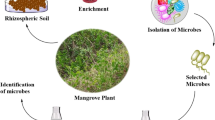Abstract
Acinetobacter baumanni was isolated from polluted soil. An attempt to study the A. baumannii to degrade dye was explored. It was found effective against azo dye and was able to completely degrade the dye under 48 h in a shake flask. Molecular analysis on the isolate A. baumanni was performed together with Hedychium flavum, and the sequence was submitted to the NCBI database to procure accession number MT192652.1. Response surface Methodology-Box-Behnken design (RSM-BBD) was used to optimize the condition and achieve 98–99% dye decolorization.
Access this chapter
Tax calculation will be finalised at checkout
Purchases are for personal use only
Similar content being viewed by others
References
Arora S (2014) Textile dyes: it’s impact on environment and its treatment. J Bioremediat Biodegrad 5(3):e146
Barikbin B, Hadinasab S, Nabavian MR (2017) Decolorization of reactive red 198 by ultrasonic process in aqueous solution. J Health Sci Technol 1(2):86–92
Fazli MM, Mesdaghinia A, Naddafi K, et al (2010) Optimization of reactive blue 19 decolorization by Ganoderma sp. using response surface methodology. J Environ Health Sci Eng 7(1):35–42
Fletcher CA, St. Clair R, Sharmina M (2021) A framework for assessing the circularity and technological maturity of plastic waste management strategies in hospitals. J Clean Prod 306:127169
Gao Y, Yang B, Wang Q (2018) Biodegradation and decolorization of dye wastewater: a review. In: IOP conference series: earth and environmental science (vol 78). IOP Publishing, p 012013
Gislin D, Sudarsanam D, Raj GA, Baskar K (2018) Antibacterial activity of soil bacteria isolated from Kochi, India and their molecular identification. J Genet Eng Biotechnol 16(2):287–294
Illanjiam S, Arunachalam KD (2012) Degradation of Azo dyes by immobilized Pseudomonas aeruginosa and Bacillus subtilis. Discov Life 1:26–31
Li K, Liu Q, Fang F et al (2019) Microalgae-based wastewater treatment for nutrients recovery: a review. Bioresour Technol 291:121934
Mishra S, Nayak JK, Maiti A (2020) Bacteria-mediated bio-degradation of reactive azo dyes coupled with bio-energy generation from model wastewater. Clean Technol Environ Policy 22(3):651–667
Papadopoulou K, Kalagona IM, Philippoussis A, Rigas F (2013) Optimization of fungal decolorization of azo and anthraquinone dyes via Box-Behnken design. Int Biodeterior Biodegr 77:31–38
Permpornsakul P, Prasongsuk S, Lotrakul P, Eveleigh DE, Kobayashi DY, Imai T, Punnapayak H (2016) Biological treatment of reactive black 5 by resupinate white rot fungus Phanerochaete sordida PBU 0057. Pol J Environ Stud 25(3):1167–1176
Prasad SS, Aikat K (2014) Study of bio-degradation and bio-decolourization of azo dye by Enterobacter sp. SXCR. Environ Technol 35(8):956–965
Satar R, Husain Q (2011) Catalyzed degradation of disperse dyes by calcium alginate-pectin entrapped bitter gourd (Momordica charantia) peroxidase. J Environ Sci 23(7):1135–1142
Shah M (2016) Microbial degradation of reactive orange M2R dye by bacterial consortium ETL-A. J Microb Biochem Technol 8(6):483–487
Srinivasan S, Shanmugam G, Surwase SV, Jadhav JP, Sadasivam SK (2017) In silico analysis of bacterial systems for textile azo dye decolorization and affirmation with wet lab studies. Clean Soil Air Water 45(9):1600734
Unnikrishnan S, Khan MH, Ramalingam K (2018) Dye-tolerant marine Acinetobacter baumannii-mediated biodegradation of reactive red. Water Sci Eng 11(4):265–275
Author information
Authors and Affiliations
Corresponding author
Editor information
Editors and Affiliations
Rights and permissions
Copyright information
© 2023 The Author(s), under exclusive license to Springer Nature Switzerland AG
About this chapter
Cite this chapter
Nivetha, V., Harini, S., Shyla, J.M., Reena, G.S. (2023). Impact of Acinetobacter Baumannii on Dye Degradation and a Molecular Analysis Study. In: Jeyaseelan, A., Murugasen, K., Sivashanmugam, K. (eds) Sustainable and Cleaner Technologies for Environmental Remediation. Environmental Science and Engineering. Springer, Cham. https://doi.org/10.1007/978-3-031-29597-3_11
Download citation
DOI: https://doi.org/10.1007/978-3-031-29597-3_11
Published:
Publisher Name: Springer, Cham
Print ISBN: 978-3-031-29596-6
Online ISBN: 978-3-031-29597-3
eBook Packages: Earth and Environmental ScienceEarth and Environmental Science (R0)




